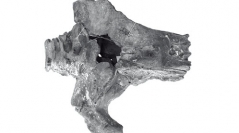

 Geodiversitas
32 (2) - Pages 331-363
Geodiversitas
32 (2) - Pages 331-363A fossil rorqual - Diunatans luctoretemergo n. gen., n. sp. - is described based on two specimens from the early Pliocene of The Netherlands and is compared to all previously described rorquals. The morphology of the new species, especially that of the elements of the petrotympanic complex, is described in detail. Main discriminating characters are: very short nasal; mediolaterally wide pterygoid fossa; large, robust and prominent occipital condyle; mediolaterally wide squamosal body lateral to the supraoccipital; dorsal bulge on squamosal; tympanic bulla very large compared to zygomatic width; wide tympanic bulla (L/W ratio: 1.24) with the sigmoid process perpendicular to the long axis of the bulla; rounded and bulbous pars cochlearis (L/W ratio: 1.23-1.26); long, slender and curved stapes; massive and square basioccipital process; wide basioccipital. A phylogenetic analysis has been undertaken based on a recently published matrix. In the consensus tree the new taxon has a basal position with respect to the Balaenoptera + Megaptera clade and constitutes therefore a stembalaenopterid. Taxonomic controversies surrounding nominal rorqual species described during the 19th century from North Sea strata are addressed. Our analysis of the type material of the species Balaenoptera borealina, B. musculoides, B. rostratella, Megaptera affinis, Megapteropsis robusta and Plesiocetus goropii lead us to declare them nomina dubia.
Mammalia, Cetacea, Mysticeti, Balaenopteridae, Early Pliocene, North Sea, anatomy, phylogeny, Van Beneden, Owen, review, new genus, new species